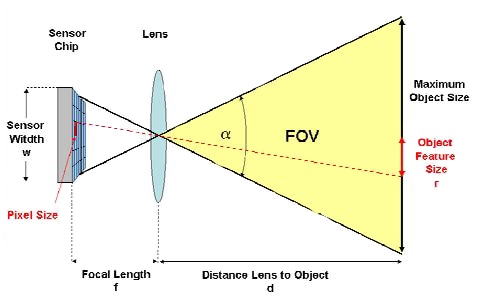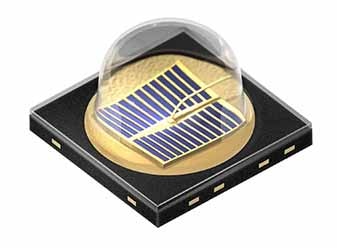Infrared LEDs Maintain the Night Watch
投稿人:DigiKey 欧洲编辑
2015-06-09
In today’s increasingly security conscious world, the market for CCTV cameras is continuing to expand globally. Technologies such as advanced IP video are driving growth in networked systems and the IoT. Superior compression standards and faster image processing are expanding the application potential. Whether used for access control, intruder alert or general crime prevention, in covert or semi-covert mode, indoors or outdoors, CCTV is widely used in the consumer/private sector, in retail and industrial premises, and in public, civic and government buildings for both civil and military applications.
When it comes to night vision and recording at low light levels, infrared LEDs are key components. IR LED illuminator modules, for example, are an essential part of most CCTV camera systems today, typically combined with sophisticated image enhancement and control electronics functions. Importantly, modern IR LEDs are more technologically advanced, more reliable and longer lasting than earlier generations.
This article will consider the selection criteria and design constraints for IR LEDs when used in CCTV camera systems, particularly for applications such as access control. The range required, for example, can be from just a few meters to 100 meters or more. High power devices deliver increased optical output, and a wide range of emission angles is available. The specific application will determine the combination of parameters required in IR LEDs. For example, far reaching illumination requires high power and a narrow cone; wide-angle devices are better suited to near-field visibility applications.
With reference to a detailed Application Note from Osram, the article will highlight the application of specific devices in the Osram Oslon Black ranges. These include the SFH4715S and SFH4725S.
Market growth
According to a report available from ReportLinker,1 the global CCTV market was estimated to be worth $23.5 billion by the end of 2014. Revenues from networked IP-based video systems were forecast to overtake traditional analog CCTV cameras for the first time last year. Increased demand for technically-advanced surveillance, including cloud-based video surveillance services, and importantly, analytics to counter terrorism, is driving growth, the report highlights.
Another report from IHS Research,2 estimates the market for video surveillance equipment and storage to be worth $28 billion by 2018. Again, the migration from analog to networked surveillance cameras is reported to be driving growth.
Within this market, access control is a growing application sector, valued at $3 billion in 2012 and projected to grow to $4.2 billion by 2017. Smart buildings are leading the transition to IP-based video surveillance for access control, according to a leading CCTV vendor. The ability to extract video data, combined with design versatility, easy configuration, and remote access to data, shows that network video is overcoming limitations previously recognized in analog systems and facilitates integration with other security mechanisms.
A just-published report by TechNavio, available from Global Information,3 covers the global video surveillance market from 2014-2019, forecasting growth at 24.08% CAGR over this period. A key market driver identified by the report is the need for high-resolution image quality. Technologies such as H.264 compression standards, advanced in-camera image processing, and widescreen HDTV monitors, combine to meet this need. IP video networking, meanwhile, is proving to be a compelling solution, as it enables increasing functionality and performance, remote accessibility to data, and facilitates data analytics, the report summarizes.
Night light source
The near infrared light spectrum ranges from 700 nm up to around 1050 nm. Infrared LEDs are proving to be a useful light source for CCTV cameras used in night vision applications and where light levels are very low. The two most commonly used wavelengths are centered on 850 nm and 940 nm. The spectral emission range matches well to the sensitivity range of standard photodiodes, phototransistors or CCD and CMOS cameras with extended IR sensitivity.
An Application Note from Osram Opto Semiconductors, entitled High Power Emitters for Illumination Applications,4 provides a useful introduction and general design guidelines for camera systems using IR illumination. In operation, reflected or scattered light from an object is detected by a CCD or CMOS camera, which generates an analog or digital signal. To ensure a high quality signal that can be further analyzed, a high output signal and low noise level is needed. In changing light conditions, the signal-to-noise ratio can drop significantly and additional artificial light is needed to improve the picture quality.
Infrared light sources are visible to the human eye up to around 780 nm, with high intensity sources being discernible as a faint red glow to around 850 nm. These lower wavelength devices are used in CCTV cameras in semi-covert applications. For covert operations, and in applications where light pollution is to be avoided, the higher wavelength devices are the preferred choice. However, fewer cameras are sensitive to 940 nm sources and the illumination range may be shorter.
Infrared LEDs are available to cover ranges from just a few meters to 200 meters or more. In general terms, for longer distances, devices with narrow beam angles, creating a long light cone, are required. For person recognition and access control applications, a range of 5 to 10 meters is typical. IR LEDs are available with emission angles as narrow as 5° and as wide as 150°.
In recent years, IR LEDs have become a lot more powerful, as well as power efficient, with top of the range models operating at 900 mW or more. This is essential for longer-range illumination and to provide better image quality for IP networked systems. Mid-range devices operate at 600 mW, while standard low-power diodes, suitable for applications such as remote control units, operate at 250 mW. Voltage requirements are typically 1.2 to 1.7 V for low-power devices, at up to 3 V for high-power emitters. DC currents up to 1 A are increasingly required for high intensity applications. Further consideration must be given to the radiant intensity of the light source (measured in mW/sr) and the reflectivity of the object, typically measured in µW/cm2. Radiant intensity indicates the light output within a solid angle segment and therefore defines the intensity of the light beam.
Guidance on calculations for the number of light intensity and power output needed for specific applications is provided in Osram’s Application Note.
Multiple emitters can be used to provide the required light output. New technology has allowed much smaller, higher power emitters to be developed, and multi-chip and stacked emitter arrays enable high intensity IR illumination sources in very small packages. However, thermal management and power dissipation are important design issues that have to be carefully considered.

Figure 1: Field of view (FOV) of a camera system.
In practice, designers also need to consider the typical object size, its distance from the camera and the desired picture resolution, the optical properties of the camera system (sensor size, objective) and its field of view (FOV). See Figure 1 above. The light emission pattern from the diodes needs to match the camera FOV as closely as possible. If the beam angle is too narrow, not all of the target may be sufficiently illuminated. If it is too wide, some of the reflected light may not be detected by the camera, thereby reducing image quality. It may be necessary to consider a secondary lens to ensure that the IR LEDs correctly illuminate the required field of view of the camera. Companies such as LEDiL offer a wide range to suit devices from various manufacturers.
Achieving the required signal-to-noise ratio depends on the spectral sensitivity and quantum efficiency curve of the CCD/CMOS chip used in the camera, and the integration time.
Typical devices
While there are a number of manufacturers of 850 and 940 nm red LEDs for CCTV camera applications, including Everlight and Vishay, Osram offers one of the most extensive ranges, with models covering wide ranges of power output, radiant intensity and emission angles, and with a number of package options.
The Oslon Black SFH4715A 850 nm infrared LED is typical of Osram’s high power, small package devices, and ideal for CCTV applications. With a power output of 800 mW and beam angle of 90°, it can be used to illuminate objects up to 100 meters away, depending on the type of external optics used. Also in the range is the 850 nm SFH4715S, with a forward voltage of 2.9 V and a half angle of 45°. Both feature a radiant intensity of 320 mW/sr.

Figure 2: Osram’s Oslon Black SFH4725S, in its black package, is designed for truly covert surveillance operations.
For covert applications, 940 nm devices are more appropriate. Osram offers the Oslon Black SFH4725S family, with a high optical output of 980 mW from an output current of 1 A. Forward voltage is 2.75 V. The SFH 4725S achieves a radiant intensity of 450 mW/sr at an emission angle of 90°, providing superior illumination over the area being monitored. Employing Osram’s Nanostack technology, the device features two emission centers in a single chip. This effectively decreases the number of devices needed for the optical output. Further, contained in a black package, the device is completely concealed behind the camera lens.
Summary
Infrared LEDs are important components in CCTV systems, providing illumination for objects under surveillance in dark and low-light conditions. Selecting IR LEDs for CCTV applications requires careful consideration of factors including output power, optical power, radiant intensity, beam angle and forward voltage requirements.
Modern devices offer higher power and increased optical output in smaller multi-chip packages, combined with increased efficiency and reliability. Advanced surveillance systems incorporate sophisticated IR illuminator units, which can be closely synchronized with camera lenses to ensure the camera’s field of view at any time is appropriately illuminated. Allied technologies, including image processing, data compression and high speed video transmission, have vastly broadened the application potential of CCTV cameras, bringing greater focus on IR LEDs and associated devices such as lenses, secondary optics and drivers.
References
- ReportLinker: Global CCTV Market Forecast to 2014
- IHS Technology, video surveillance market growth
- Global Information/TechNavio: Global Video Surveillance Market 2015 to 2019
- Application Note: High power emitters for illumination applications, Osram

免责声明:各个作者和/或论坛参与者在本网站发表的观点、看法和意见不代表 DigiKey 的观点、看法和意见,也不代表 DigiKey 官方政策。






 中国
中国